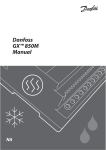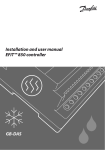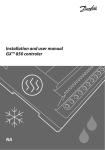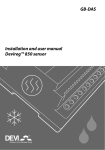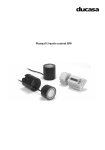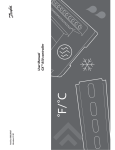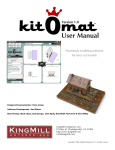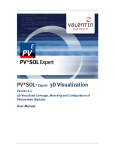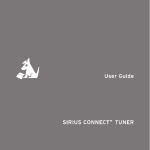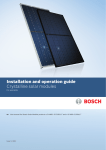Download Installation and user manual EFIT™ 850 sensor GB-DAS
Transcript
Installation and user manual EFIT™ 850 sensor GB-DAS 1 Table of content 2 1 Sensors and control zones . . . . . . . . . . . . . . . . . . . . . . . . . . . . . . . . . . . . . . . . 3 1.1 Sensor types and function . . . . . . . . . . . . . . . . . . . . . . . . . . . . . . . . . . . . . 3 1.2 Control zones . . . . . . . . . . . . . . . . . . . . . . . . . . . . . . . . . . . . . . . . . . . . . 4 1.3 Assign sensors to control zones . . . . . . . . . . . . . . . . . . . . . . . . . . . . . . . . . 5 2 Placing and installation of sensors . . . . . . . . . . . . . . . . . . . . . . . . . . . . . . . . . . 6 2.1 2.1.1 Placing the first ground sensor in a zone . . . . . . . . . . . . . . . . . . . . . . . . . . . 6 2.1.2 Placing the following ground sensors in a zone . . . . . . . . . . . . . . . . . . . . . . . 6 2.1.3 Example with ground sensors . . . . . . . . . . . . . . . . . . . . . . . . . . . . . . . . . . 7 2.1.4 Extending the ground sensor cable . . . . . . . . . . . . . . . . . . . . . . . . . . . . . . . 7 2.2 Installing ground sensors . . . . . . . . . . . . . . . . . . . . . . . . . . . . . . . . . . . . . 8 2.3 Placing roof sensors . . . . . . . . . . . . . . . . . . . . . . . . . . . . . . . . . . . . . . . . 10 2.3.1 Placing the first roof sensor in a zone . . . . . . . . . . . . . . . . . . . . . . . . . . . . . 10 2.3.2 Placing the following roof sensors in a zone . . . . . . . . . . . . . . . . . . . . . . . . . 10 2.3.3 Guiding plates . . . . . . . . . . . . . . . . . . . . . . . . . . . . . . . . . . . . . . . . . . . 10 2.3.4 Example with roof sensors . . . . . . . . . . . . . . . . . . . . . . . . . . . . . . . . . . . 2.3.5 Extending the roof sensor cable . . . . . . . . . . . . . . . . . . . . . . . . . . . . . . . . 11 2.4 3 Technical specification . . . . . . . . . . . . . . . . . . . . . . . . . . . . . . . . . . . . . . . . . 13 4 Appendix A – PSU & feeder cable . . . . . . . . . . . . . . . . . . . . . . . . . . . . . . . . . . Placing ground sensors . . . . . . . . . . . . . . . . . . . . . . . . . . . . . . . . . . . . . . 6 Installing roof sensors . . . . . . . . . . . . . . . . . . . . . . . . . . . . . . . . . . . . . . 11 12 14 1 Sensors and control zones This section guides you through a short introduction to the terms used in the manual - - - - Area type Sensor type Controller Control Zones Finally you will be able to assign a number of sensors to the chosen control zones. 1.1 Sensor types and function Identify the type(s) of area prepared for the Danfoss ice and snow melting system, by looking fig. below: 1. Walkways and parking areas 2. Steps and stairs 3. Roofs and roof edges 4. Gutters and down pipes For ground areas like 1 and 2 you have one or more ground sensors. 3 2 4 S W E N 1 For roof areas like 3 and 4 you have one or more roof sensors. The ground and roof sensors both measure two things on the sensor surface - temperature - moisture from ice, snow, hail or rain These measurements are input to the EFIT 850, and it decides how the ice and snow melting system should control the heated areas. Details about the setup of the controller can be found in the EFIT 850 installation manual. 3 1 Sensors and control zones 1.2 Control zones A EFIT 850 and up to 4 sensors are able to control an area as a single zone, but can also control more areas as 2 separated control zones. 2 control zones consits of minimum 2 heating elements + 2-4 sensors and can be: Combi zones = when you have both a roof and a ground area Dual zones = e.g. if steps should have a better performance than a walkway If the power supply is limited, both combi and dual zones gives you the possibility to prioritize which zone to operate first. A EFIT 850 and up to 4 sensors give the following 5 control options: Zone type Single zone ground 1-4 in one zone Single zone roof Combi zones 1-3 in one ground zone Dual zones ground 2-4 split in two zones Dual zones roof 4 1-4 in one zone 1-3 in one roof zone 2-4 split in two zones Maximum 4 sensors in all 1 Sensors and control zones 1.3 Assign sensors to control zones There are some good reasons to have 2 or more sensors in one control zone. - Higher degree of detection safety, which is relevant for larger, complex or busy roof and ground areas. - Approx. 1 hour faster ground system, as one sensor measures the ground temperature and other sensors measure the moisture whereas a single sensor must switch between temperature and moisture measurements. Now decide how the ice and snow melting system should be operated and assign the sensors to the control zones. In case of questions the system designer must be consulted. Draw circles around Zone type and 1-4 Sensors Single zone ground x Single zone roof x Combi zones x Dual zones ground x Dual zones roof x 1 1 2 3 2 3 2 3 4 1 2 3 1 2 3 2 3 4 Maximum 4 sensors in all 4 4 5 2 Placing and installation of sensors At this point you must have identified and assigned sensors to the control zones as prescribed in section 1. In this section 2 you will be guided through a correct placing and installation of the sensors. For placing and installation of ground sensors see section 2.1. For placing and installation of roof sensors see section 2.2. 2.1 Placing ground sensors Placing ground sensors in appropriate spots is very important for the performance of the ice and snow melting system. The appropriate spot must fulfill some characteristics, where the below 2 are the most important: The sensors must be placed minimum 1 meter within the boundaries of the heated zone The sensors must not be covered or prevented from being exposed to snow or rain. This includes dirt, leaves and pebbles. 2.1.1 Placing the first ground sensor in a zone Find one who knows the area and make him describe the area function and weather conditions. The first ground sensor in a zone must now be placed where the first snow appears. The appropriate spot can be found by following below steps. a) b) c) Where the heated area is in shade all day. Look e.g. for algae. Where e.g. a wind shield make the snow drift Where the most traffic from shoes or car wheels happens If you have a dual zone system, the first sensor for the other zone must be placed by following the same steps above. 2.1.2 Placing the following ground sensors in a zone The following ground sensors in a zone must be placed where the surface dries up last. The appropriate spot can be found by following below steps. d) e) f) Where the heated area is in shade all day Where the melting water accumulates e.g. due to hollows in the area So the whole zone is covered, but min. 1 meter from other sensors If there is doubt about the appropriate spot, prepare a second spot for later use. 6 2 Placing and installation of sensors 2.1.3 Example with ground sensors 1 2 In this example a lower step section (1), a walkway platform (2) and an upper step section (3) is heated. Depending on number of zones and detection safety, 2-3 ground sensors is installed. 3 Sensor no. 1 is the most important as this is placed where snow is likely to appear first due to shade and snow drift also because the spot is stepped on by pedestrians. 1 2 Sensor no. 2 is also important as the platform is object to water puddles. Here the shaded spot will dry up last. If the power supply is limited, the platform could be a low priority zone in a dual zone system. 3 1 2 3 Sensor no. 3 is relevant if more detection safety is required, as additional to sensor no. 1. Can be prepared for later installation. 2.1.4 Extending the ground sensor cable The ground sensor consists of two parts, a sensor part with a sensor cable and a sensor tube. A 15-meter cable is supplied with the sensor part. Approx. 0.5 m of this cable should be coiled inside the bottom of the sensor tube, leaving 14.5 meter to be connected with the EFIT 850 controller. If the appropriate spot is located out of this range, a feeder cable extension for the sensor may be needed. This sensor cable extension must be a 4-wired cable with a diameter in accordance with the table in Appendix A – Sensor cable extension. Note each new colour of the 4 wire cable feeder extensions (white, white, red and black) Dual zone sensors: Do NOT join feeder cable extensions from separate zones 7 2 Placing and installation of sensors 2.2 Installing ground sensors At this point you must have located the appropriate spots for the ground sensors and extended the feeder cable if necessary as prescribed in section 2.1. The sensor part and the sensor tube may now be installed in connection with the actual construction work and connected at a later date. The following applies for all types of installations. a) The base below the sensor tube must be hard, e.g. a concrete plate or similar, in order to ensure that the sensor is not pushed into the ground if e.g. a lorry runs over it. The tube is designed to be mounted on a plate using the two screw holes inside the tube. illustration_a_b_c b) Place the sensor tube in between the heating cables with a minimum distance of 1 cm. cm m m in .1 in .1 m Assembly box Feeder cable illustration 2 c) The sensor tube must be positioned so that it is flush with the surrounding terrain and so that the sensor part must be placed so that the upper brass illustration 6.1.1.3 surface is horizontal. d) Lay a conduit for the sensor cable between the sensor tube and the EFIT 850 controller. installation pipe 8 2 Placing and installation of sensors Installation in asphalt: The temperature around the sensor part and sensor tube must not exceed 80°C. A wooden dummy or similar must replace the sensor while asphalt is poured and cooled down. The conduit must be a metal tube that can withstand the high temperatures. Not OK! illustration 6.1.1.3 OK! e) Ensure that the sensor tube is closed with the supplied cap before the concrete is poured or the bricks are laid. Make sure that air gaps are filled with cement. f) Coil approx. 0.5 m of the sensor cable inside the tube. If the sensor cable needs extension, see section 2.1.4. g) Place the sensor part inside the sensor tube until it is horizontally flush with the edge of the sensor tube and rests on the collar inside the tube. installation pipe with sensor cable h) The sensor part may be inspected using the two holes around the edge of the s ensor tube. The grooves on the outside of the sensor part correspond with the holes in the sensor tube. 9 2 Placing and installation of sensors 2.3 Placing roof sensors Placing roof sensors in appropriate spots is very important to the performance of the Ice & Snow melting system. The appropriate spot must fulfil some requirements, where the below 2 are the most important: The sensors must be placed minimum 1 meter within the boundaries of the heated zone The sensors must not be covered and prevented from being exposed to snow or rain. This includes dirt and especially leaves in the gutters. 2.3.1 Placing the first roof sensor in a zone Find one who knows the area and make him describe the area function and weather conditions. The first roof sensor in a zone must now be placed where ice and snow cause most problems. The appropriate spot can be found by following below steps. a) Where the heated area is in shade or oriented to the north/west b) In the main gutter close to the main down pipe If you have a dual zone system, the first sensor for the other zone must be placed by following the same steps above. 2.3.2 Placing the following roof sensors in a zone The following roof sensors in a zone must be placed where the surface dries up latest . The appropriate spot can be found by following below steps. c) Where the snow slides e.g. due to roof joints or gutter valleys d) In other gutters, close to other down pipes e) So the whole zone is covered, but min. 1 meter from other sensors If there is doubt about the appropriate spot, prepare a second spot for later use. 2.3.3 Guiding plates If a roof area is oriented to the south and the roof slope is steep it can be exposed to strong sun radiation. In that case it can be necessary to install guiding plates above the sensor, so the slowly dripping melting water from the roof hit the roof sensor. If there is doubt about the appropriate spot, prepare a second spot for later use. 10 guiding plate 2 Placing and installation of sensors 2.3.4 Example with roof sensors In this example a roof with several dormers is heated. Depending on the number of zones and required safety it is relevant to install 2-3 roof sensors. 1 2 Sensor no. 1 is placed in shady side of the front. It is the most important as all melting water passes the sensor until the gutter is dry. As snow is likely to slide down here, the spot is one of the last to dry up. 3 1 12 23 3 1 2 3 Sensor no. 2 is also important as the shaded dormer roof is more flat, which might cause sudden snow slides on a dry roof. The dormers could be the lower prioritized zone in a dual zone system. Sensor no. 3 is relevant if a higher detection safety is required. It could both be placed near another down pipe or in the gutter valley. Thus it can be an additional sensor to both no. 1 and 2 and can be prepared for later installation. 2.3.5 Extending the roof sensor cable The roof sensor is a sensor part with a sensor cable built in one. A 15-meter cable is supplied with the roof sensor to be connected with the EFIT 850 controller. If the appropriate spot is located out of this range, a feeder cable extension for the sensor may be needed. This sensor cable extension must be a 4-wired cable with a diameter in accordance with the table in Appendix A – Sensor cable extension. Note each new colour of the 4 wire cable feeder extensions (white, white, red and black) Dual zone sensors: Do NOT join feeder cable extensions from separate zones 11 2 Placing and installation of sensors 2.4 Installing roof sensors At this point you must have selected the appropriate spots for the roof sensors and extended the feeder cable if necessary as prescribed in section 2.3. The roof sensor may now be installed in connection with the actual construction work and connected at a later date. The following applies for all types of installations. a) The sensor must be placed between or next to the heating cables, with a distance of minimum 1 cm between sensor and heating cable. b) The sensor must be placed so that the upper brass surface is horizontal. If the sensor is placed on an angled roof, the sensor must be levelled until the surface is horizontal. c) Fasten the sensor by using the attachments on the sensor or glue it to the surface. 12 min. 1 cm 4 Technical specification Technical data Type number: - Ground - Roof D850 G1 Sensor D850 R1 Sensor Voltage: 24VDC +10%/-20% (18-26VDC) Power consumption: • Ground • Roof Max. 13W Max. 8W IP class: IP 67 Ambient temperature: • Ground • Roof -30˚C to +70˚C -50˚C to +70˚C Sensor type: Devibus connected moisture sensor(s) Sensor lead: 15 m of 4x1 mm2 (may be extended in accordance with the table in appendix A) Indication: 2 x 16-character illuminated display. Measurements • Ground sensor • Sensor tube (ground) • Roof sensor Depth = 87 mm; Heigth = 74 mm Depth = 93 mm; Height = 98 mm Depth = 15 mm; Height = 23,5 mm; Width 216 mm 13 3 Appendix A – Sensor cable extension Ground system Number of sensors: Cable type 1 mm2 1,5 mm2 2,5 mm2 4 mm2 1 or 2 3 4 Max length (m) 300 450 750 1200 Max. length (m) 150 225 380 600 Max length (m) 80 120 200 310 Roof system Number of sensors: Cable type 1 mm2 1,5 mm2 2,5 mm2 4 mm2 14 1 2 3 4 Max length (m) 400 600 1000 1600 Max length (m) 100 150 250 400 Max length (m) 130 200 330 525 Max length (m) 75 110 190 300 Dual zone sensors: Do not join sensor cables extensions from separate zones zone A sensor I II sensor II zone B sensor III III Red Bla c Wh k it Wh e ite Red ck Bla te i Wh e it Wh 1 2 3 4 5 6 7 8 “Red” “Black” “White” I Sensor cable extension according to above table is led to EFIT™ 850 “White” Note each new colour of the 4 wire cable sensor extensions (white, white, red and black) 15 Article: 088L8076 Version: 01.01 ˚C
















